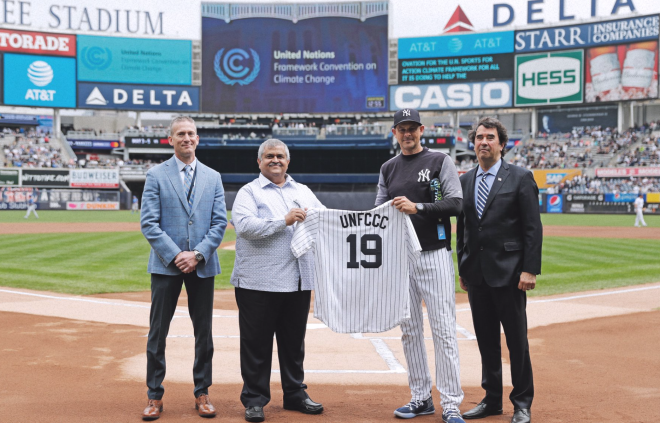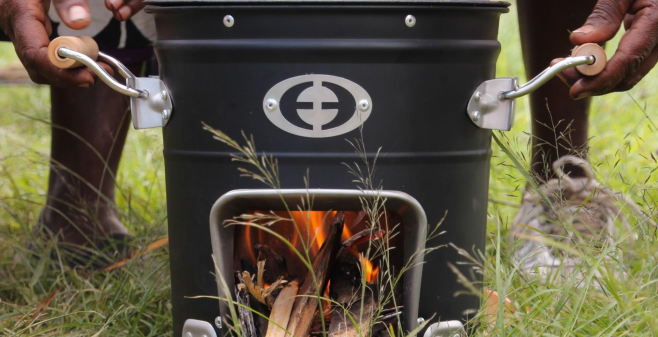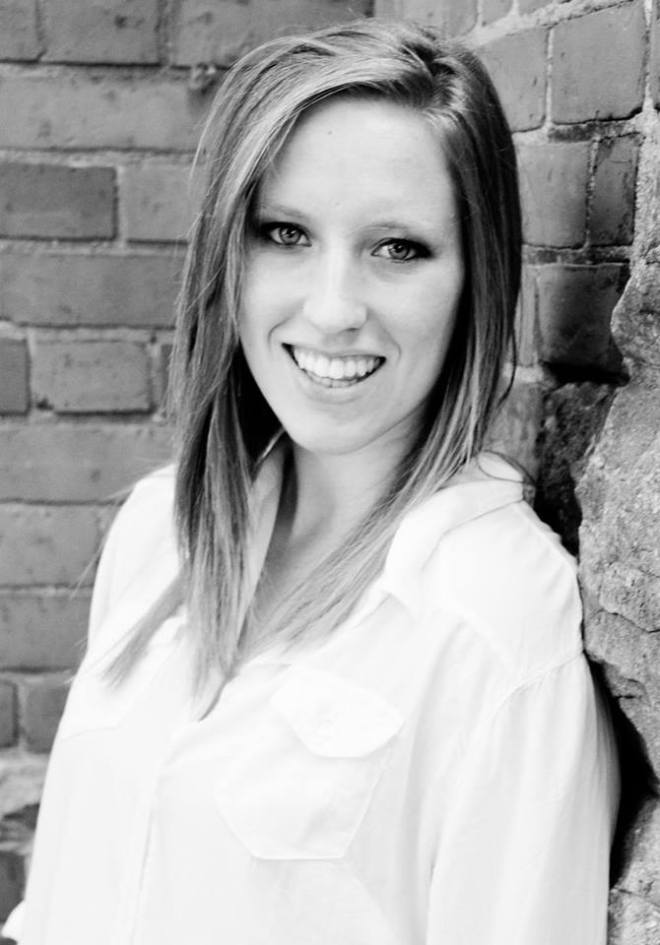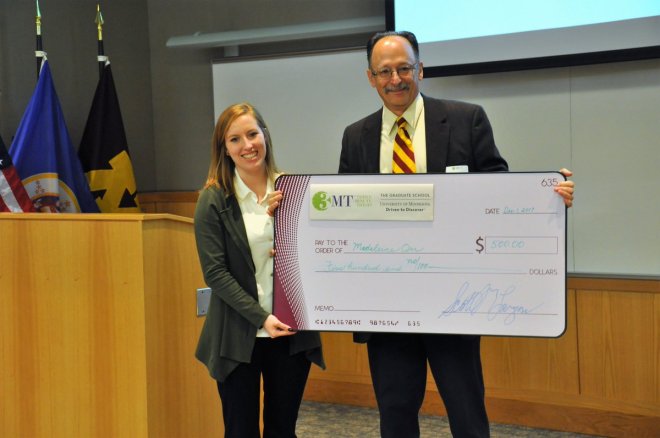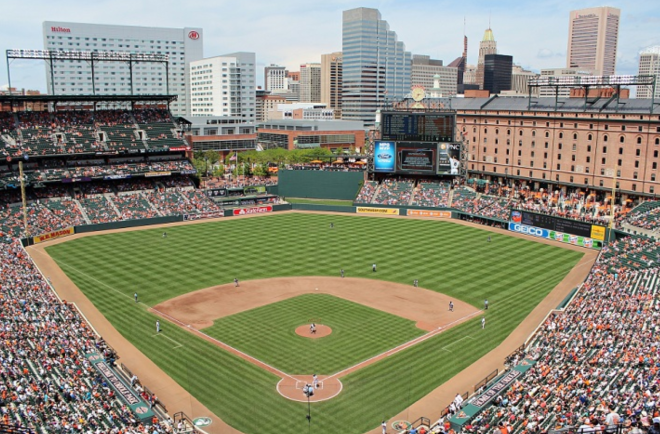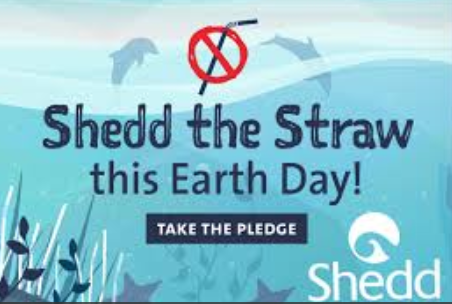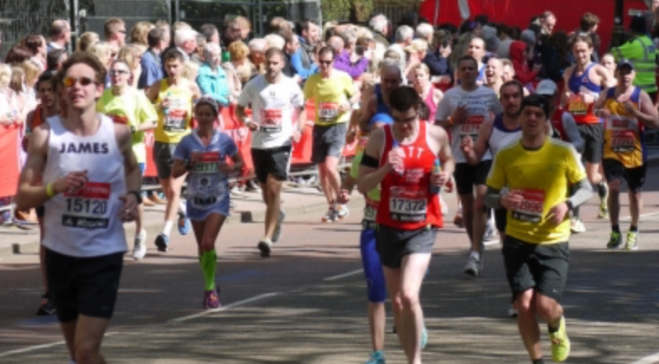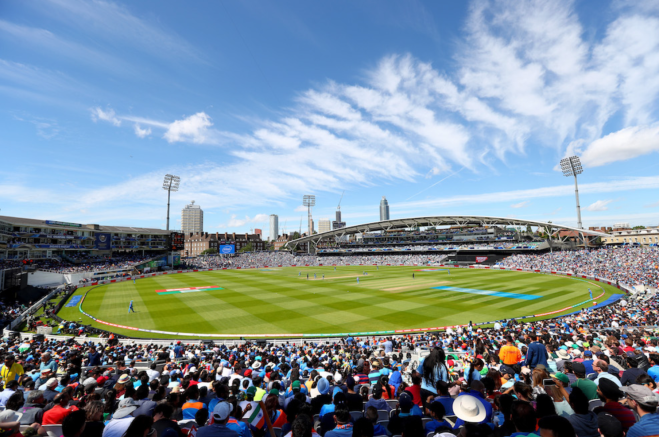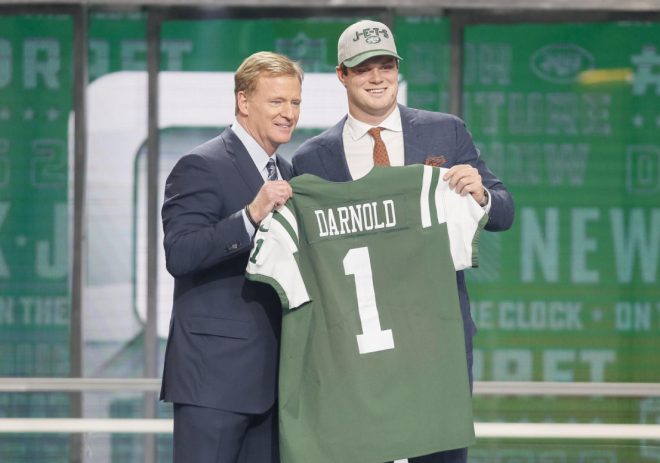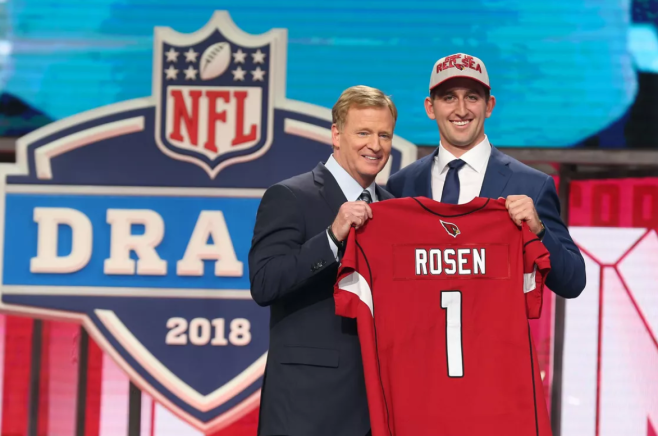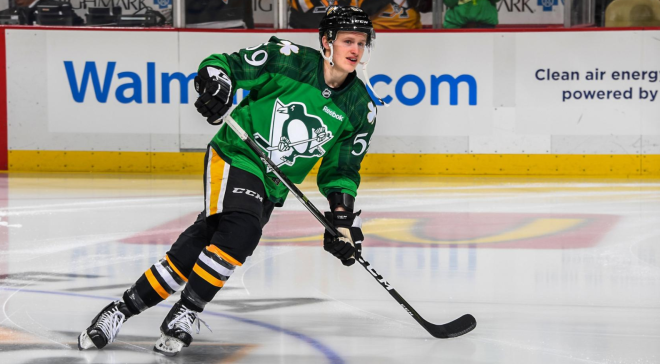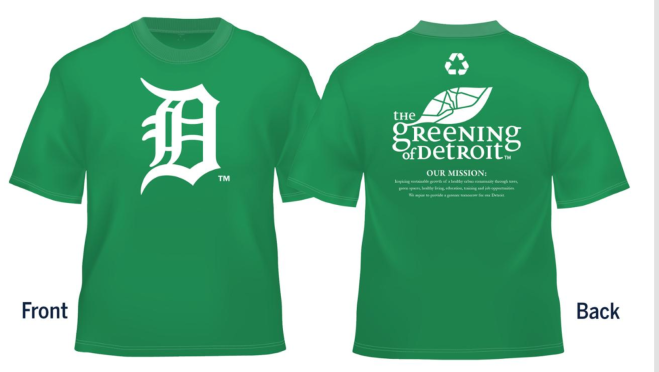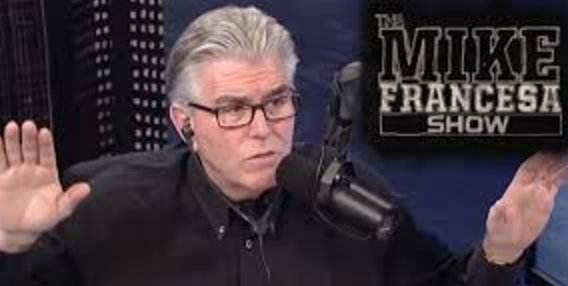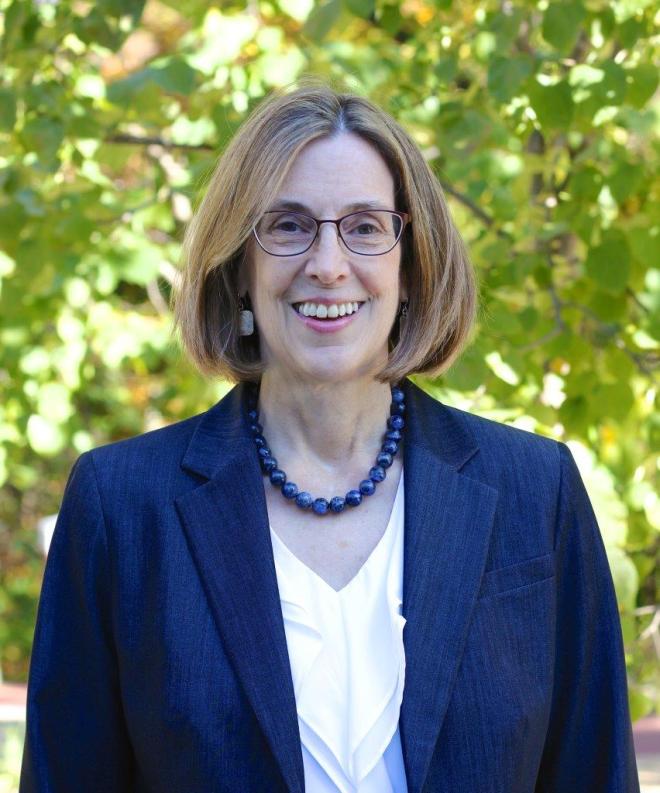Welcome to Day III of GreenSportsBlog’s Earth Week extravaganza!
Click here for Monday’s brainstorm among Green-Sports luminaries to find big, “Moon Shot” ways for sports to impact the climate change fight. And click here for Tuesday’s story about the New York Yankees’ strong climate change statement.
Today we turn to Major League Soccer, which just completed its “Greener Goals Week of Service.”
MLS’ efforts surrounding sustainability earned it the title of No. 1 most responsible football league in the world according to ResponsiBALL, an annual report ranking the most prominent soccer leagues based on actions related to community and environment.
GSB believes MLS is perfectly positioned to lead on Green-Sports. Its fan base is the youngest of the five North American major professional men’s sports leagues. Young people “get green” at far higher percentages than their older counterparts.
We spoke with JoAnn Neale, MLS President and Chief Administrative Officer, about the league’s sustainability efforts, including what’s new this season. Before that, we delved into how Neale came to her unique role as one of the most senior female executives across all major professional sports leagues.
GreenSportsBlog: JoAnn, I have so many things to get to — the history of Major League Soccer and its Greener Goals program, how the league can leverage green more powerfully than it has to this point, where climate change fits into the league’s green messaging. But first, how did you come to run MLS’ greening initiatives?
JoAnn Neale: I grew up on Long Island and started playing soccer when I was five years old. Playing soccer and being an athlete was a big part of my identity. I also always had a dream of being a lawyer and an intention of going into litigation.
GSB: …Saying “I object!” and “May I approach the bench?” always sounded exciting to me! Was it?
JoAnn: While at NYU Law School, I had an internship in a firm’s litigation division and realized it wasn’t for me. The idea of going to court was exciting, but the reality was most cases take years before they get to court and a heavy focus is on research.
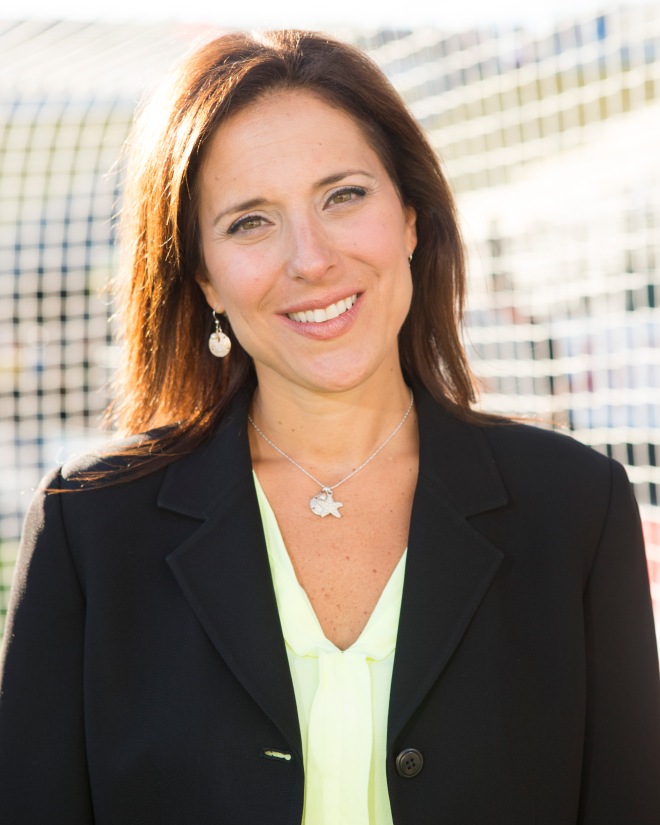
JoAnn Neale (Photo credit: Major League Soccer)
GSB: So what did you do?
JoAnn: After law school, I was fortunate to land a job at Latham & Watkins. I did transactional work and realized my love for negotiating and working with clients in a collaborative way. The concept of getting alignment from both parties and overcoming obstacles to have the same end goal was always intriguing. It was really fulfilling work.
GSB: How and when did soccer come into the picture?
JoAnn: While studying for the bar exam in law school during the summer of 1994, my friends and I would take breaks and watch the World Cup games that took place in the USA that year. It was then that the formation of Major League Soccer was announced. I recall thinking it would be interesting to be part of the creation of the league. Ultimately, two lawyers at Latham & Watkins were involved with the founding of MLS. Fast forward a couple years and a friend of mine had gone to work at the league. Two months later, she said there was an opening in the law department and I joined in 1998.
GSB: What did your friends and family say? Going from a big firm to a new soccer league?
JoAnn: People said, “You’re crazy!” and ‘Why would you want to do THAT?!’ But it felt right and it was.
GSB: It must’ve been very exciting being at what was essentially a startup. What was your role in those early days?
JoAnn: The first four-to-six years I primarily did legal work. After that, I expanded into other areas like Human Resources and projects like spearheading a team responsible for all the logistics of moving MLS to our current headquarters in Manhattan.
In 2006, the executive team discussed the need for creating a social responsibility platform. We believed it was important to give back to the communities in which we live and play our games, as well as to our fans. I raised my hand and said I would like to lead the charge in developing the platform. MLS WORKS launched in 2007.
GSB: Congratulations! What is MLS WORKS’ mission?
JoAnn: MLS is dedicated to using soccer as a vehicle for positive social change. Through MLS WORKS, MLS and its clubs seek to enrich the lives of those in need across the United States and Canada.
From executing national programs and legacy projects, to charitable giving campaigns, MLS creates sustainable communities and promotes inclusion at all levels of the game. MLS WORKS has a strategic four-pillar approach to corporate social responsibility.
- Soccer For All – This signifies that everyone is welcome to MLS, regardless of race, color, religion, national origin, gender, gender identity, disability, sexual orientation or socioeconomic status.
- Youth Enrichment – This includes our work with the U.S. Soccer Foundation to build soccer pitches in inner cities.
- Kick Childhood Cancer – The league “goes gold” throughout the month as part of the Kick Childhood Cancer campaign to raise awareness and funds for Children’s Oncology Group.
- Greener Goals – The initiative kicks off this week with the Fourth Annual Greener Goals Week of Service leading into Earth Day weekend.
GSB: Not surprisingly, I’d like to hear more about Greener Goals. What kinds of programs are under that heading?
JoAnn: MLS has committed to measure, reduce and offset the league’s greenhouse gas (GHG) emissions and promote healthy, sustainable communities throughout the United States and Canada, and areas in need throughout the rest of the world. Our clubs activate in different ways. Some have been heavily focusing on reducing food waste, others on raising awareness around plastic pollution, others on recycling, etc.
GSB: Can you share some examples?
JoAnn: Of course! On food waste, Sporting Kansas City provides fans with easy-to-implement tips on reducing food waste. Orlando City SC is partnering with the city of Orlando to deliver food waste to an energy/fertilizer plant at Walt Disney World. Seattle Sounders FC use compost from CenturyLink Field to grow vegetables at a nearby farm. On plastic waste, FC Cincinnati…
GSB: …The league’s newest expansion team…
JoAnn: That’s right. The club worked with Newport Aquarium to drive awareness, attention and action around Earth Day. Fans bring single-use plastic bags to the team’s matches and the Newport Aquarium where collections will be taken on-site. On Earth Day, a special event was hosted to demonstrate the impact the bag collection will have on local Cincinnati-area waterways and its wildlife, and at a larger scale in oceans. Students at local schools and after-school programs will help repurpose the bags into useful items, including sleeping mats for the area’s homeless community.

FC Cincinnati’s Emmanuel Ledesma (l) and Greg Garza show off their new reusable bags created using recycled plastic bags at the Newport Aquarium (Photo credit: FC Cincinnati)
On energy, Real Salt Lake has a 2020-kilowatt (kWh) solar panel system at Rio Tinto Stadium which offsets approximately 73 percent of the organization’s total annual stadium power needs.
GSB: I knew about their solar installation but I didn’t know it offset such a high percentage. That’s great news. The Seattle Sounders recently committed to go carbon neutral. What does that mean exactly?
JoAnn: You’re right. The Sounders are the first professional soccer team in North America to go carbon neutral. The club worked with Seattle-based Sustainable Business Consulting to calculate its greenhouse gas emissions and develop plans to reduce its impacts where possible. For sources unable to be eliminated – such as team travel for matches, scouting and other business – Sounders FC is offsetting the club’s emissions through the Evergreen Carbon Capture (ECC) program of Forterra, a nonprofit that works for regional sustainability. Using the club’s contribution to ECC, Forterra and its partner DIRT Corps are joining with the team and its fans to plant hundreds of trees in a part of the region that needs added tree cover.
GSB: That’s impressive, JoAnn. I know the league is also involved in carbon offsetting as part of Greener Goals. What emissions is MLS offsetting and what kind of offsets did the league purchase?
JoAnn: Well, first I want to thank Allen Hershkowitz…
GSB: …Environmental Science Advisor for the New York Yankees…
JoAnn: …and also Doug Behar, VP of Operations with the Yankees. They shared the offset program the Yanks embarked upon and we said, “MLS has to be involved!” So we started by offsetting emissions, including executive travel, surrounding the MLS All-Star Game. It was fitting that the 2018 All-Star Game was played at Mercedes-Benz Stadium in Atlanta, a venue that is LEED Platinum. In 2018 MLS compensated 5,400 tons of CO2 equivalent associated with hotel accommodations, ground transportation, staff, player, executive and MLS guest travel, and stadium operations as part of MLS All-Star Week and MLS Cup in Atlanta, in addition to player travel during the Audi MLS Cup Playoffs
To date, MLS’ investment has created tangible, constructive impacts for local communities that were generated by the distribution of 4,407 improved cook stoves in rural communities in Kenya. As of October 2018, the use of these cook stoves are estimated to have positively impacted the lives and wellbeing of 15,000 women and children.
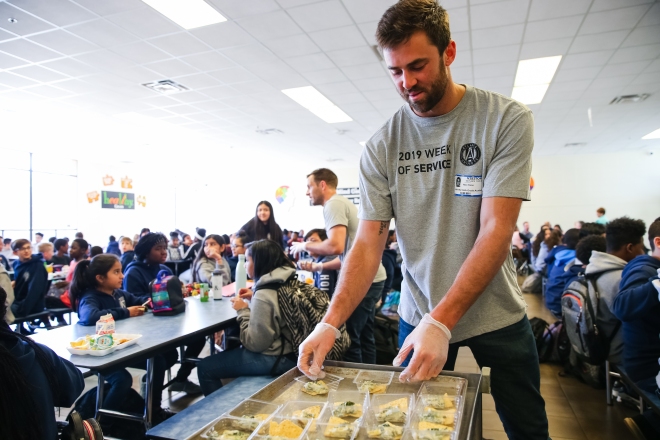
Mercedes Benz Stadium, the first LEED Platinum football stadium in the USA, hosted 60 Marietta Middle School students for the stadium’s first sustainability tour in which the students learned about the venue’s greenness. In conjunction with the tour, Atlanta United’s players helped educate students about sustainable food choices, healthy eating and the environmental impact of locally sourced foods, followed by a taste test competition. Here Atlanta United goalkeeper Alec Kann serves up some of the tasty dish he cooked up (Photo credit: Atlanta United)
GSB: That’s important work. How did you communicate the Greener Goals expansion to MLS fans? Did you air PSAs in stadium and/or on TV broadcasts?
JoAnn: Social media was big for us — Facebook and Twitter in particular. Our Greener Goals messaging focuses on what MLS and our clubs are doing in or near the stadiums and in the communities that our teams play. Our Greener Goals PSAs focus on what we’re doing in or near the stadiums from an environmental perspective.
GSB: Really? I think the carbon-offsets-cookstoves project would make for a great PSA. Beyond the offsets, how else has MLS expanded Greener Goals?
JoAnn: All 24 MLS clubs wore special adidas-Parley eco-friendly kits over Earth Day weekend. These innovative uniforms are made with Climalite technology and built of technical yarns created with Parley Ocean Plastic™, made from up-cycled marine plastic waste, as a part of the global adidas x Parley initiative. The collaboration with adidas to support Parley for the Oceans also serves to encourage fans to decrease their use of single-use plastics and reinforcing the importance of changing human attitude and behavior towards plastic pollution.
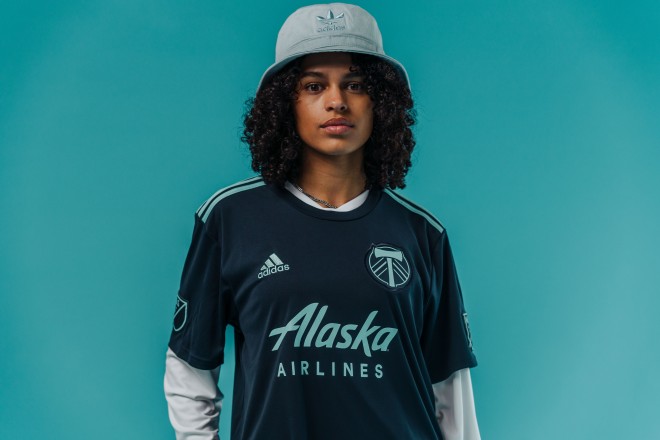
The Portland Timbers version of the adidas Parley for the Oceans eco-friendly jerseys worn by all MLS players over Earth Day weekend (Photo credit: MLS)
GSB: Love that program — but why only use the Parley uniforms during Earth Week? Couldn’t all teams use Parley unis all the time?
JoAnn: Great question, Lew. We’re exploring that option.
GSB: Good to hear. I have one last question: Does MLS include climate change in its Greener Goals messaging?
JoAnn: Not yet. MLS does not want to get into a political debate on climate change. Rather, we want to focus our efforts on improving lives by reducing greenhouse gas emissions, increasing recycling, and more.
GSB: I think MLS is missing an opportunity by not directly talking about climate change with its fans. As discussed earlier, the demographic groups that make up the MLS fan base — Millennials, Gen-Zers, Hispanics — are also demanding real action on climate. My bet is that MLS fans would reward the league for linking its Greener Goals program to the climate change fight.
